
Introduction
In 1950 and 1952 Hugh Tracey set out with a team including his wife, a sound engineer, and two drivers, to scour Southern and Central Africa looking for musicians to record for the International Library of African Music, based at Rhodes University in South Africa. There had been some recording in parts of Africa, what you might call the edges, but there was no sustained recording in the fertile heart, places like Congo, until after World War II. There had been no serious effort before Tracey to do anything of this scope, and on these epic safaris he preserved some beautiful recordings that resonate to this day. Household names like Jean Bosco Mwenda were unknown until Tracey chanced upon him busking in a town square. His earliest recordings won prizes and were eagerly copied by American and European folkies, and were acknowledged in London as "the Best Music of 1952". Tracey's archives (discussed on another page) form the basis of our understanding of much of the tribal music of Congo, Uganda, Kenya, Tanzania, Zambia, Malawi, Mozambique and other countries he visited. He wrote up his trips in the Newsletter of the African Music Society and I decided to reprint them here, with some of my own photos taken in the same locations. In my case I did not know in advance I was going into the Ituri Forest to meet the Ba Mbuti pygmies, or I would not have sold my Walkman Pro which I brought along, but I was susceptible to a huge cash offer for it from an Indian trader in Nairobi, so my experience of their music was as fleeting as the evening rains. AJ
RECORDING TOUR, MAY TO NOVEMBER 1950 EAST AFRICA
by Hugh Tracey
from the Newsletter of the African Music Society, vol 1, no 4 (June 1951)
1950 will remain a memorable year for our research team, as it gave us our first introduction to the music of East Africa. The tour included primarily Tanganyika, Zanzibar, Uganda and Kenya, with brief recordings in Southern Rhodesia and Nyasaland on the way north. It proved to be one of the most enjoyable African tours I have yet made, not only for the music itself but for the outstanding kindness of officials and private individuals, European, African, Indian and Arab, whom we met on our journey and also for the magnificent scenery which characterises most of the country traversed. We saw the four highest mountains of Central Africa, the largest lakes, great herds of game and the Rift valley scenery, which surely is unsurpassed on the continent.
This tour, which was to prove so enjoyable, began with near tragedy. Three strokes of bad luck within one week shook us to the foundations. First, our recording van broke its crankshaft shortly after entering Tanganyika, and in so doing split the engine-block in two. The local garage at Mbeya located a new engine for us and brought it in by air freight. No sooner had the engine arrived than our African recording assistant was taken off to hospital with acute appendicitis and nearly died, before he decided to stay with us after all. The worst of the three was yet to come. On the following day our South African native lorry driver, in my absence at Tukuyu, decided to ignore all our strict rules and regulations, and handle petrol in camp within a few feet of where he was boiling some tea for himself. The inevitable conflagration gutted our pack-lorry with all our camping equipment, cooking utensils, some of our recording gear and a considerable amount of personal property. This was the hardest blow of all, as it meant reorganizing the whole of our expedition at short notice and relying, not upon camping out and looking after ourselves, but upon wayside hotels and rest-houses and the hospitality of friends. But even here our luck held good, and we found that amenities, few and far between as they are in East Africa, were much more prevalent and much better than we had anticipated. In fact in many ways it was a blessing in disguise as it relieved us of the necessity of catering and cooking for most of the time. Accommodation, on the other hand, was always difficult, and we constantly wished we had our burnt tents.
We were greatly encouraged at this stage by the cheerful presence of our Tanganyika Representative of the African Music Society, Mr. Hans Cory, Government Anthropologist, who gave us three weeks of his valuable time to introduce us to Tanganyika. We could not have had a better companion. His encyclopaedic knowledge of the people, his philosophy and constant good humour soon brought everything back into perspective and started us off happily on our year's recordings. Mbeya, I feel, would have given us a better start had it not been clouded by these three disasters. We left the town with the experience of outstanding hospitality and general enthusiasm, particularly on the part of the Provincial Commissioner, Mr. A. A. Oldacre, the Principal of the Mbeya Government Secondary School for African Girls, Miss M. Hancock, and the District Commissioner of Tukuyu, Mr. E. Kingden, amongst many others. We for our part did not do Mbeya justice, and we only have a handful of recordings to show for that baleful week.
Once we had crossed the Southern Highlands to Iringa, our luck turned, and within a few hours of entering the town we had discovered one of Africa's outstanding musicians. The uncle of the present Paramount Chief of the Hehe turned out to be a skilled performer on the Ligombo zither, a three-foot long trough zither, resonated by a large gourd, an instrument which reminded one of the Indian sitar. The Hehe tribe, from the little we saw of them, would appear to be potentially a very musical people. They belong to the list of African tribes which use a full heptatonic scale in place of one of the simpler pentatonic. Apart from Pancras the Ligombo player, we found little evidence that this potential talent was being exercised.
Leaving Iringa behind, we crossed the Rift valley on the road to Dodoma, and here it was we had the impression that we had at last entered Central Africa. At Dodoma, Hans Cory introduced us to the Gogo, one of the Bantu peoples who have come under the influence of that remarkable Nilo-Hamitic tribe, the Masai. The Gogo seemed to raise one of two reactions amongst local Europeans. Those who evaluate a tribe by its economic standing were disappointed. Others, who appreciate the integrity of a simple pastoral and, indeed, poetic existence, retained an enthusiasm for the Gogo and their ways, which was later well reflected in the conversation of an ex-District Commissioner who had become very attached to the tribe. Hans Cory was already well known to them, and the Paramount Chief did not disappoint us when, at Cory's invitation, he staged a party for recording.
My impressions of that day's work are filled with superlatives. In all my experience of Africa, I had not heard better chanting than we recorded that afternoon and late into the evening, as the red-ochred, pigtailed, decorative young men sang and danced for us while their young women gave brilliant performances on the drums. Many of their songs lasted a full five minutes without any repetition and we were forced to ask them to abbreviate some of them for the purposes of recording.
If what we heard that afternoon was any criterion, anyone who sets out to study the music of the Gogo is bound to be well rewarded.
From Dodoma we took the train to the Coast, on local advice. We were assured that it would be well-nigh impossible, with the roads and pontoons in their present state, to do the journey by motor vehicle. So, riding in luxury with our three motor tracks behind us, we arrived the next day at Dar-es-Salaam.
Bad management on my part and regrettable ignorance of the strictness with which Mohammedans observe the fast of Ramadan almost led to a major disappointment on the Coast. But the kindness of officials, the sagacity of the Liwali of Dar-es-Salaam and the keen enthusiasm for their music on the part of several of the outstanding musicians, overcame sufficient of the Ramadan inertia to enable us to make some very fine recordings in the town.
Here we encountered music which was entirely new to us coming up from the south. The influence of the Arabs, as opposed to that of the Europeans, appeared to us to be a far more vital musical force, and one which has left the Coast African with a strongly poetic sense. In particular I would like to mention the enthusiastic members of a little local music club. This club (under the somewhat inappropriate name of "The Egyptian Musical Club", as it has no connection with Egypt) was started by two brothers, whose enthusiasm for Swahili music has inspired a considerable number of their fellows on the Coast. The younger brother, Bom Amberon, a self-taught musician, is gifted beyond the usual, and his recordings of "Naha-wande", "Hijazi" and "Sika", all three Arabian in inspiration, have made an excellent addition to our African library of music. In particular, his playing of the Arab "Oud", called locally by the Swahili "Udi", an unfretted lute of the guitar family, must be mentioned. His style and technique have a marked resemblance to the Moorish music of Spain.
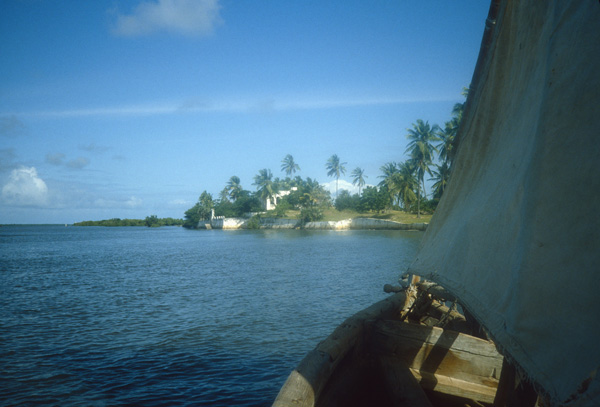
African coast near Dar Es Salaam
Another interesting phenomenon on the Coast is the widespread influence which gramophone records of Brazilian music have recently had upon the people. Dance bands in all East African towns are playing Africanized versions of Brazilian rumbas, congas and sambas. They play them without the financial backing which would enable them to perform on the normal instruments. One or two of them managed to produce an ancient violin, a discarded clarinet or half-strung mandolin, but for the rest, improvised instruments were the rule. In place of saxophones and trumpets they sang through horns and kazoos. The general effect was what Americans would call "corny", but so vital and full of rhythm that it raised everyone's immediate enthusiasm.
This South American flavour was also noticeable on the Island of Zanzibar, which we visited a week later, where brass bands of the old German pattern dispensed similar music. Another most interesting phenomenon on the Coast is the influence of Indian music upon the Coast African. A dealer in gramophone records at Mombasa later told me that of all external musical influences the Indian is now by far the greatest on the Coast. He said it was reflected in the proportion of sales. The truth of his remarks was immediately underlined by a native African customer who came in and bought an Indian record as I stood there. This would have been unheard of in a place like Natal where no Indian influence can be traced among the local Zulu.
Apart from the Swahili themselves (whom we found slow to respond, but once they knew us, delightful to work with), the tribes from the interior, in particular the Nyamwezi, were only too glad to sing and perform. Here we discovered another outstanding artist of the tour in the person of Idi Selimani, an accomplished comedian-actor and leader of a group of singers, all of whom are clearly devoted to him. Without having had a lesson in his life, he demonstrated a set of mime gestures which would be the envy of any academy student. We left Dar-es-Salaam promising ourselves a return visit at a time when Ramadan did not have its daylight stranglehold upon the inhabitants.
Returning again to the interior by train, we set out for the next stage of our tour from Tabora. This included the thickly-populated country south of Lake Victoria, where the Sukuma people and their offshoots number the best part of a million. This was Hans Cory's special country and after a few enjoyable days recording the miners at the Williamson Diamond Mine we made for Mwanza on the Lake, which Hans Cory has made his headquarters for his exhaustive anthropological studies of the Sukuma people. Here again we found a Bantu people who had come under the spell of the Masai, and it was reflected in their chanting which in several respects contained similarities to that of the Gogo. The Sukuma, we felt, was another tribe which would well repay a musicologist's attention. Their love of music has led them into a highly-organized set of secret and semi-secret societies in which dancing and singing form a major activity. Their love of dancing I expect might in fact hamper a musicologist, who might well find them far keener to dance than to sing.
It had been our intention to cross the Lake to the west side by boat, but a breakdown in one of the two Lake steamers before we arrived made this impossible, so we set off to do the long journey round the southern half of Lake Victoria via Shinyanga and Biharamulo. Here, established in the old German fortress, Mr. Charles Smith, the very cheerful bachelor District Commissioner, made arrangements for us to record some of the local performers. This was our first introduction to music which had Hima influence, of the type we were to experience in considerable quantities during the next few weeks. The people here were a very simple peasantry--a simplicity which was reflected in their music, and quite unlike that of their more developed neighbours to the immediate north. This country at the lower end of Lake Victoria is far from being a hospitable stretch of land. The moment one's motor car slowed down to about 15 m.p.h. on an upward slope tsetse flies came pinging onto the windscreen and made one uncomfortably aware of the considerable domain these insects have pegged out for themselves in most of tropical Africa.
Once around the corner of the Lake, the colour of the landscape changed from Africa's tawny yellow to the eternal green of a coastal belt. Driving up the east side of the Lake one enters the country which receives the benison of lake climate and high rainfall with its consequent high fertility. At Bukoba the Haya people gave every sign of being one of the most cultured and wealthy of East African tribes. The aristocratic intrusion of the Hima into this part of the world had left its residue of ritual and ceremonial songs, introduced to us with courtesy and unusual charm by the chiefs of the countryside. Their large banana and coffee shambas covered the tops of the rolling hills with concentrated agriculture so rarely seen in any of the territory further south. It was here that we found our next outstanding African artist, named Habib bin Seliman, a name which reflects the extent of Arab influence so far inland. Chief Gabriel Lugabandana was very keen for us to record his zither player who, he said, was the best singer of legends in all the Haya country. Our subsequent recording of the legend, which accredited their tribal origin to the Spirit of the Lake, was a masterpiece of narration. It lasted about 15 minutes and the reciter was word-perfect throughout, the accompaniment of his seven-string deep-toned zither giving an appropriate air of solemnity to the whole performance.
It was here also that we recorded our first canoe songs and were introduced to the music of the one-string lute, which is such a feature of the music of Uganda. We left Bukoba with regrets and a feeling that it was another district in which anyone interested in African music would be well rewarded with original compositions.

Jenda School, pupils coming to see the wazungu, Bunyaruguru, Uganda
We also had the impression that Bukoba is a district in which great social changes will shortly be made on account of the feminist movement which is turning the local social structure upside down. This most interesting phenomenon, virtually an "anti-slavery" movement on the part of the women, is bound to be reflected in their local arts. Bukoba will be a test case as to whether an African tribe which is inherently artistic in many directions, architecturally, musically, in domestic utensils and other crafts, is capable of standing up to western material intrusion, western education and great economic advance through the growing of cash crops such as coffee, and yet retain its integrity. Will inertia and self-indulgence defeat this tribe, which incidentally is one of the few in Africa whose numbers are falling?
The demi-paradise of the Lake country of Uganda is almost unbelievable to a traveller who has come up from the south with its torrid miombo forest and uninhabitable bush. We went first to Kampala to make our official contacts and found there a veneer of materialism amongst the Africans not equalled anywhere else in our experience except in the large southern towns. It took us several days to find who the musical people might be, but having once done so we discovered signs of an artistic and musical life of an unusually developed degree centering around the Kabaka's court. The Kabaka, the "king" of the Ganda people, has retained in large degree the panoply of a royal house, a characteristic which dates from the invasion of the autocratic Hima who have had so large a hand in the cultural establishment of central and western Uganda. One would naturally have expected to find ceremonial music in these circumstances. This was equally true of the court of the Mukama of Bunyoro to the west, though it was not so developed in either Toro or Ankole.
We journeyed through these four districts, but were unable to visit their relatives, the Watussi, across in the Kivu district of the Belgian Congo.
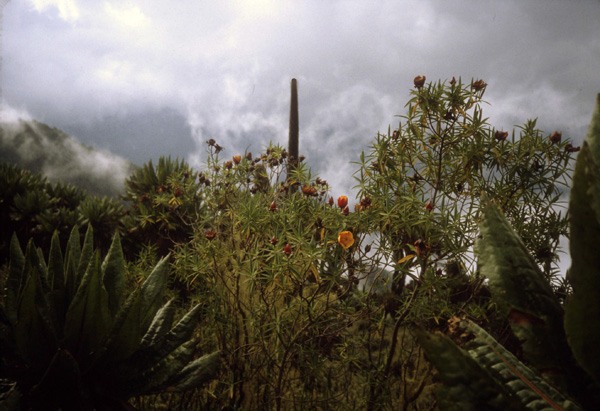
Ruwenzori mountains
It is not possible to come to any conclusion after so brief a visit on the musical potentialities of the four western kingdoms of Uganda, but we may be permitted a few general observations from the recordings we were enabled to make. Of the four, Toro and Ankole appeared to be in the grip of a kind of inertia, touched with a degree of unreality, indicative of a country far removed from outside influences. In these two kingdoms the Hima element seemed to be out of touch with and set apart from the rest of the community. In Ankole we recorded the two extremes, with music more primitive than anything we had yet experienced in Africa. Even the rhythms were utterly simple. The social and artistic development of the pastoral overlords had failed to penetrate, it would seem, to the lowest levels.
Toro, whose beautiful rolling hills are covered with elephant grass (which the rest of agricultural Africa would call "Napier fodder") lies under the magnificent Ruwenzori range. Masterly inertia appeared to be their forte, a fact which the agricultural department underlined when it claimed that three out of every four banana trees in the district were of the bitter variety, suitable only for making drink.
The music of the people I find invariably reflects their mentality and personal foibles. It is not surprising, therefore, to find social and political attitudes reflected in the arts, and in Toro a fair proportion of drinking songs. With one or two exceptions in this Toro district, the better music we heard came from the more virile folk living high up on the slopes of the Ruwenzori, where from below one could see their small patches of cultivation hanging like bark cloth blankets onto the steep slopes which disappeared into the mass of soft clouds which constantly shrouded the peaks. The District Commissioner at Fort Portal, Mr. Nigel Oram, took us round behind the Ruwenzori range to see the Pygmies and the Wamba who live on the edge of the great Ituri Forest. It was an unforgettable day, from a scenic point of view, though somewhat disappointing musically.
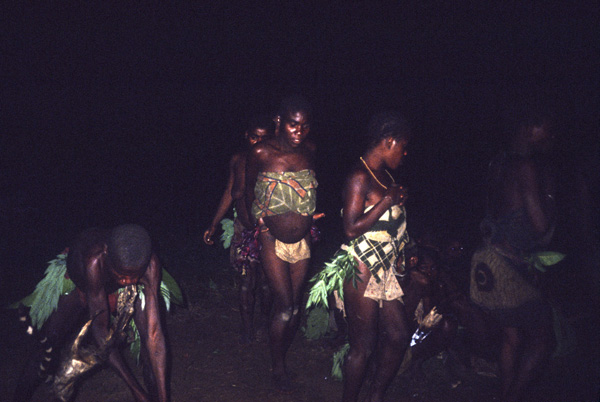
Mbuti Pygmy dance
The Pygmies are an intractable people and would have demanded several days of preparation before recording--days which we could not spare. In spite of previous arrangements claimed to have been made on the part of the Native authority, no word of our visit had arrived in advance at Bundibugyo which was our destination. The Saza Chief whom we found taking a case in his local court rose splendidly to the occasion by releasing all the prisoners in his gaol to come and sing for us. Everyone enjoyed himself. It was a day's outing both for ourselves and for the prisoners which will not soon be forgotten.
Travelling north again and leaving behind us the fertile fields of Toro, we visited the headquarters of the Mukama of Bunyoro at Hoima. There was a sense of vitality in the air which was reflected in the music, both instrumental and sung, which the Mukama and his lieutenants had arranged for us. We were particularly impressed with the musicians who play for all royal occasions, the makondere gourd trumpet bands, the small goblet-shaped ntimbo drums and the virile dance music so noticeably lacking further south.
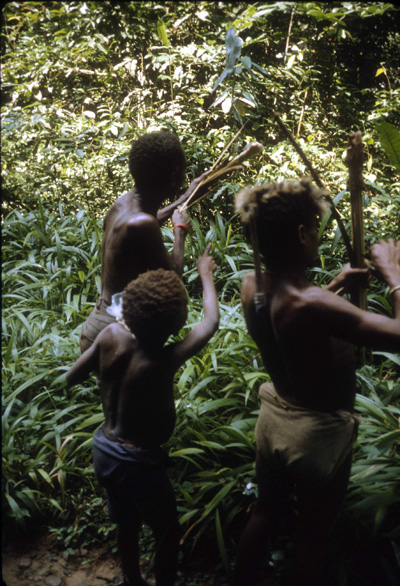
Pygmies hunting in the Ituri rain forest
Our Bunyoro visit included a short excursion north of Masindi to meet the other Chopi people, who share the same name but few of the characteristics of the famous xylophone players of Portuguese East Africa. We were shown and recorded the music of a couple of dances and one or two Likembe (Mbira) tunes which, on the face of it, would not recommend these Nilotic Chopi to the student who is working for active music in Africa.
We completed our short journey through the kingdoms by returning to Kampala, where friendships struck up on our first visit now matured into recording sessions. Three sessions were specially interesting. Firstly, our recording of the public entertainers who are employed by the local municipality to sing, play and dance for the patrons of the public beer hall. Our three African assistants with the expedition were spellbound by the pelvic gyrations of the beautifully dressed female dancers, a style of dress, incidentally, which for grace and colour can only be equalled in our experience in the southern Congo by that of the Kasai women. The professional players of the lutes, lyres and drums rasped out their songs with the ease of artists born to the stage and perfected by long hours of public entertainment. They were expected to entertain the customers from 10 in the morning to late afternoon. They did. It was a pleasure to record such professional artists.
The second occasion was our visit to the Lubili Palace of the Kabaka, where we were fortunate in being entertained with the music of two royal bands, both the "Entenga drum" and the "Flute and Drum" bands. They play in the several courtyards of the Palace, which are constructed in traditional style and are surrounded by tall reed fences. The Flute and Drum band is entrusted with the duty of waking up the Kabaka's household early in the morning, of playing at various intervals during the day and finally of bidding the household goodnight when they retire to bed.
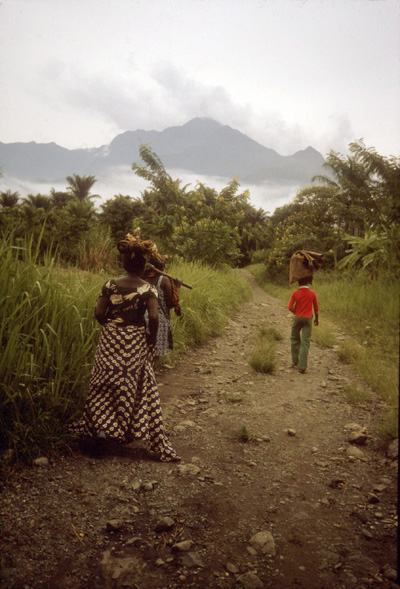
The Entenga Drum band consists of 15 well-tuned laced drums, 12 of them attached to a long pole and lying along the floor of the reed hut where the musicians play. Three large bass drums stand at one end of this line. The twelve were tuned to two octaves of a pentatonic scale. The six drummers produced a number of most exhilarating tattoos upon this grand array of timpani.
Our recording the same evening in the great cathedral of Namirembe produced an equally moving if highly contrasted musical experience, when the choir sang some of the religious music of the cathedral--William Byrd, da Vittoria and Palestrina, under the direction of E. Kaizi, their talented conductor and organist. With the one exception of the "Singers of the Copper Cross" in Elisabethville, we have heard no religious music so well performed by Africans as that which we recorded that late September afternoon at Namirembe Cathedral.
These three incidents are proof enough that the Ganda people of the territory are capable of social and musical organization of a high order in spite of the fact that in their own compositions they do not appear to have progressed beyond the pentatonic modes common to the less musical tribes. Western materialism has a great attraction for the Ganda, but, if our experience of them is any criterion, they will not readily lose their birthright for a mess of politics.
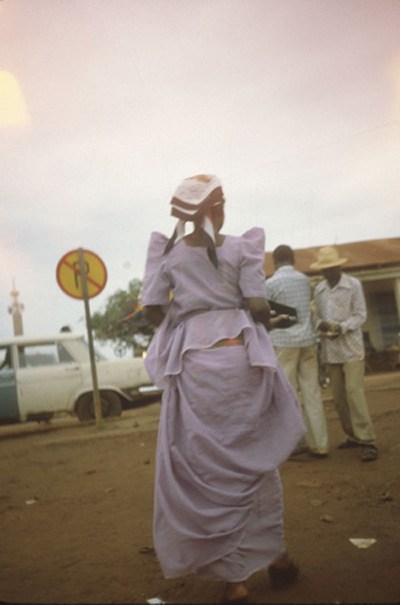
Jinja, Uganda
Soga, the fifth Uganda kingdom, with headquarters near Jinja, also proved musically interesting. The Soga are an independent people, with what appears to be a strong leaning towards home rule. Our recording in this area was highlighted by a simple flute tune, which we recorded shortly after midnight at the headquarters of the Kyabazinga, the Paramount Chief or "King" of the Soga. There was also a number of Mbira bands locally called Budongo, which are played by groups of young men and are much in demand.
The fact that the Budongo has no long history in the country would indicate a very active future for this most musical little instruments, particularly when it is played in ensemble.
In Eastern Uganda where the profitable coffee is grown, the usual cultural disintegration caused by material success appears to have set in, though from what one sees, reads and hears it is doubtful whether the Gishu peoples of the Mount Elgon region were ever to be compared artistically with their neighbours.
Crossing the border into Kenya produced another of those dramatic changes in African culture. Here we arrived in the heart of that independent and forthright Nilotic tribe, the Luo. Everywhere they sang to the sound of their large gaily painted lyres. Songs about the kindness of their rich relatives filled the air. Stringed instruments are the speciality of the Luo, and in addition to the 8-stringed Thum lyre the one-stringed lute is played with remarkable technique.
The mixed tribes of the Kakamega area immediately to the north of Kisumu demonstrate in no uncertain manner the cultural chaos which has been produced by European material and educational intrusion. The young people of whole districts within range of certain institutions have been forbidden to dance, with the all too natural and inevitable social consequences which follow upon dictatorial intrusion of a type foreign to the people and divorced from their natural habits. As an interested traveller, albeit with considerable experience of African tribes elsewhere, I find the lack of courtesy and good manners in areas where music has been the first to suffer from outside influence is always noticeable to those who are sensitive to these things. The Kakamega district is no exception. How different was the atmosphere a few miles away up in the beautiful hills of Kapsabet where the Nilo-Hamitic Nandi people performed for us through the kind arrangement of their enthusiastic District Commissioner, Mr. Abrams. The Nandi on their grass-covered hills, and their cousins, the Kipsigis, on the hills on the opposite side of the great Kavirondo valley which separates them, were two of the most attractive and cheerful of all the African communities we have had the pleasure of recording. Their joie de vivre, their manners and sense of fun, their lissom movements and their love of bright colours all combined to produce that elusive characteristic which is properly employed in the word "charm". Local enthusiasm on the part of Europeans for the Nandi and the Kipsigis is certainly understandable from the few days recording we had with these two tribes. As music, their performances were simple, unpretentious and pentatonic, but what they lacked in complexity they more than made up in vitality. I have noticed since returning home that whenever members of my party refer to our recording sessions with the Nandi or Kipsigis they do so with a smile of pleasure.
At Kapkatet where young Kipsigis men and girls recorded for us one very wet day we experienced the full charm of their little wishbone-shaped lyres played softly to songs of unusual poetic virtue. Both tribes are adept at the performance of their round dances, where individual dancers come into the centre of the circle and spring like pogo sticks into the air, in what appears to be impossible slow motion. I measured the height that several dancers cleared in a single leap. They held themselves erect and without bending the knees leaped in time with the music from 16 to 18 inches straight into the air. All these lakeside people, with the exception of that confused conglomeration who have lost touch with the arts of Africa would well repay the work of musical students. I can think of no single area where greater pleasure for any research man is inherent in the countryside. Scenically, it has everything from the high hills down to the valleys and plains of the lakeside. In human talent it has a special contribution to make to African music.
Our next major move was to cross the highland region between Kericho and Nakuru, down through the lovely Rift valley and climb up into the highlands on the other side. Here the local Representative of the Society, Dr. R. R. Scott, whose hospitality we enjoyed and whose forethought and kindness we had already begun to experience in the Lake Province, had made full arrangements to record both the Kikuyu and the Kamba. It was no reflection upon Dr. Scott's careful arrangements or upon the many people who so generously helped us in the Nairobi area that these two tribes proved, for good reason, to be disappointing.
The history of the Kikuyu appears to indicate an unmusical background which in this respect sets them apart from the average African tribe. Not only do present-day observers remark upon their lack of musical talent but from all written accounts this characteristic seems long established for many generations past. It is significant, for example, that the dance bands playing in Nairobi both for Europeans and Africans are all composed of coastal or lake people, and that any kind of musical instrument is rarely seen in the streets.
The case of the Kamba is rather different. They live mostly in a large reserve to the east of Nairobi, and have a great reputation as acrobatic dancers which our brief experience of them at Machakos amply proved. But the use of dance music alone does not indicate a musical people, and the dance music of the Kamba is highly percussive with a minimum of melody. So much so is this the case that, by and large, the gramophone alone is patently not the right method for recording of Kamba art. It would require sound film to do justice to the undoubted talent of the young Kamba boys and girls who perform their special cheek-to-cheek dance with such abandon. If our brief observations confirm the experience of others, then it would appear that on the highlands of Kenya we have two large African tribes who present a somewhat negative field for the musicologist and therefore must be rated well below the average in this direction.
Leaving Nairobi by way of the game plains, we returned south to Tanganyika and the volcanic mountains of Meru and Kilimanjaro. The Arusha clan of Masai recorded music as happy and direct as that of our Nandi and Kipsigis groups further north, but under Mount Meru there was another Bantu tribe, like the Gogo, which has succumbed to the enchantment of the Nilo-Hamitics. One bright afternoon they provided a most brilliant spectacle as well as interesting music for our machines. We were not forewarned either by our European or African contacts for what we were to meet.
We took a winding and somewhat precipitous mountain-side track to the rendezvous where the Paramount Chief of the Meru tribe had collected his people. On our arrival, we found on an open slope covered with short green grass a mass of about 1,000 men and women all prepared to sing and dance. Their costumes and their cosmetics were the most colourful that we had experienced in the whole of our East Africa tour. Dancing in files, men and women in alternate rows, company after company of dancers moved rhythmically up and down the sward, the men holding their great Masai-type spears and shields, the women most beautifully attired in bright beadwork. Both had applied many different shades of ochre yellow, pink and white, with vermilion and blue in bold designs all over their faces. From this description, one might conclude that this represented "barbaric" splendour, but our impression was indeed the opposite, for the Meru men we saw were as handsome and the women as pretty as anything Africa has to show. Their habit of dancing with the chin uplifted and thrust forward adds to the astonishing dignity and loveliness of the whole performance.
Our recordings were greeted with more than the usual enthusiasm, and our brief visit to the Meru is one we shall not readily forget.
It confirmed once more the impression we had gained in other districts that the Nilo-Hamitic tribes and those who have fallen under their influence have a natural charm of personality which is denied to the average run of Bantu people. To artistically sensitive persons they are a group of distinctive culture and integrity, no matter how literate or illiterate, materially successful or unsuccessful they may happen to be. It was these people who in the past drove the weaker hordes up into the foothills of the great mountains, there to become rich in due time on the cultivation of the imported coffee-bean.
The materially successful tribe, the Chaga, of the lower slopes of Kilimanjaro seem at present to have little or nothing to contribute to African art. Financial success, coupled with a literary education, has not apparently given them cultural advancement but the status of colourless plebeians. Naturally, with their heaven-sent prosperity flowing down the mountainside from the melting snows of Kilimanjaro, they are said to consider themselves a people set apart and superior in all ways to the nomads of the dry plains below. Of their relative happiness, who is to judge?
One of the Chaga Chiefs--a most interesting and hospitable person, with whom I had an opportunity of conversing on several occasions, maintained that his people's most outstanding talent was an "ability to breed like rats". When one remembers that this single tribe has no less than seven dialects so remote that no one understands them all and that their background is a conglomerate of refugees with only the common denominator of defeat at the hands of the plainsmen, it is not surprising that their arts fall far behind those of the tribes whose history has not experienced such a lack of continuity.
The last lap of our journey took us back to the Coast down the long line of Pare and Usambara mountains, the great sisal-growing districts of Tanganyika, back to the softer influences and atmosphere of the Swahili Coast. Mombasa, like Dar-es-Salaam, proved to be a place of poetry and languid charm, which we can readily believe is the direct result of contact with scores of generations of Arabs. It was a pleasure to meet the local musicians and to make records with cheerful well-mannered folk.
From Malindi on the north coast where the Liwali Sheik Mohammed Hamid Timani made arrangements for us to record Arab music, to Mombasa itself where the officials both African and European gave us every facility, the last three weeks of our journey proved as interesting as any we had had in the previous six months. We were again impressed with the genuine and developed musical feeling of the Swahili, who subscribe to the Arab method of performance to the violin, the udi, the dambuk earthenware drums and the flutes. Recording sessions lasted long into the night, and once we became accustomed to the musical idiom we found ourselves falling under the spell of their improvisation, which so clearly affected the audience sitting around in the same way as it affected us. The Arab sword dance, stick dances and the distinctive dress which has so markedly influenced the coastal people, all contributed to this friendly cheerful musical atmosphere which is such a part of the life of the Mohammedan coast. As far as we know, there has been no serious effort to study in detail the musical culture of the Swahili people in Kenya and Tanganyika and the islands of Pemba and Zanzibar. The few recordings we were fortunate enough to make will indicate to any student of African music what a vast field there is to cover in this coastal belt alone.
For the great variety of music alone, quite apart from the friendliness of the people, no matter to what race or of what social standing they belonged, our East African tour could not have been more happy.
This short account has merely touched upon a few of the highlights. It has been impossible to mention by name the scores of white officials and individuals who went out of their way to assist us and who clearly drew a certain satisfaction and pride in the achievements of the people they administered, or the many outstanding Africans who showed their appreciation of our work and were glad of the promise of local records to come.
Artistically, the East African tribes appear to us, with few exceptions such as the Chopi, to be far more mature than those tribes in the five or six territories further south. There is not a member of my recording team (without whose enthusiastic support such a tour would have been impossible), who does not look forward with pleasure to a return visit to East Africa.
The concrete evidence of our six months journey is contained in over a thousand high fidelity recordings, most of which we hope will shortly be printed and find their way back to their homelands to the many singers and instrumentalists who played for us, and their appreciative audiences in the towns and villages of East Africa.
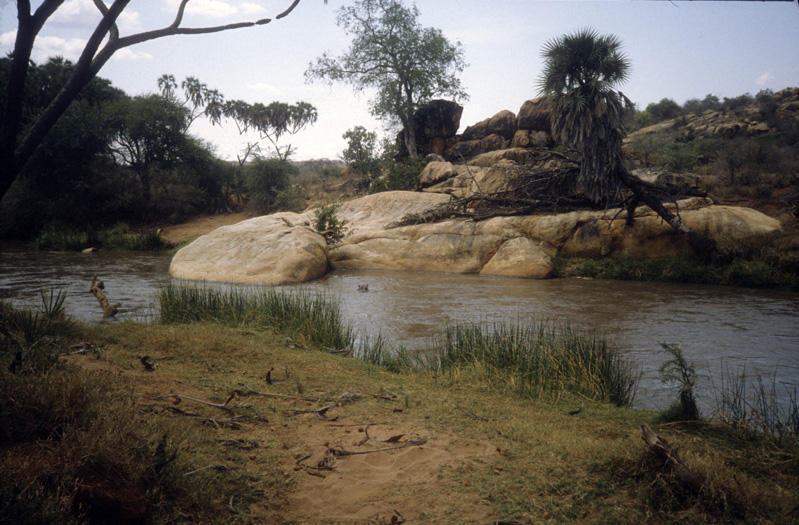
Hippo in Tsavo game park, Kenya
Part II
RECORDING IN EAST AFRICA AND NORTHERN CONGO
by Hugh Tracey
from African Music Society Newsletter, vol 1, no 6 (Sept 1953)
The recording tour arranged for 1952 took us through East Africa on our way to sample the music of Northern and North Eastern Congo. To save 3,000 miles of road before starting our recordings we went up by sea from Durban with our vehicles on the deck. Mombasa was our first recording date and we experienced again the special charm of this friendly and interesting town of such mixed communities, Arab, Indian, Swahili, up-country African and European, who seem to demonstrate how happily a mixed community can get on together. No outstanding musicians were available on this occasion and we drove on up into the interior to see what we could find on the slopes of Kilimanjaro.
It was a surprise to learn that the only direct road into Tanganyika was theoretically closed and opened only by permit. The volcanic mud apparently makes it almost impossible to maintain a hard-surfaced road in wet weather and so traffic to and fro during storms is strictly controlled. We were lucky and were allowed through at once by applying for a permit at the border.
Several days at Moshi were spent in trying all the known methods of making contact with Chagga musicians. The result was as disappointing as it had been in 1950. One is left with the only conclusion that either the Chagga are very shy of singing to strangers, a characteristic which would sound ridiculous to anyone who knows them well in any other sphere of vocal communication, or else music is to them a very minor consideration in Chagga life. The latter was the consensus of opinion held by most Europeans who knew them best. A history of petty faction fighting between sections of the population living on various flanks of the mountain has now been entirely displaced by a fervent co-operative preoccupation with the economics of growing coffee beneath that superb snow capped dome of Kibu. It has totally eclipsed any musical inclinations they may have had.
We knew from past experience that an emotional upset of any kind can temporarily throw even a highly musical community out of its stride and we were most disappointed to find that the Meru nearby at Arusha were in the middle of just such a trouble. A few families had to be moved from the northern slopes of Mount Meru to another site and the tribe was digging its heels in. We had hoped to get a colour picture of their dancing and more recordings of their exhilarating singing. Everything was dumb. Not a sound of music or dancing in the whole district. This was not to be our last disappointment of 1952 and it impressed upon us the rule which we had so often experienced elsewhere, that nothing ever happens the same way twice in Africa. If you do not take your recording today or your photograph now the opportunity will certainly not repeat itself upon your next visit. The season will be wrong, the old chief will have died or the musician will be visiting his cousin beyond the river and will not be back for at least a month.
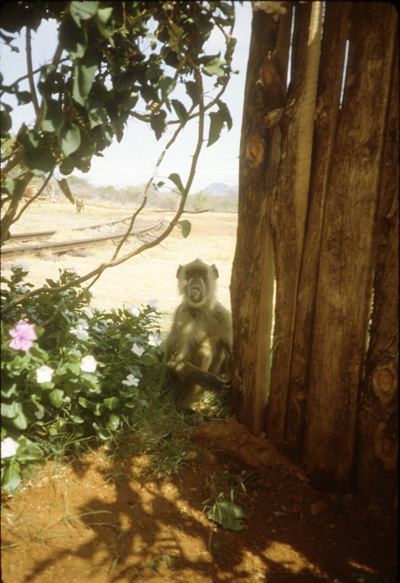
monkey at Maneaters, Kenya
We left for Nairobi having one amusing encounter with a group of young Masai men and girls who loped up from their manyatta in the valley below, tossing their long locks and greeting us with laughter and good spirits as if we had been the friends of a lifetime. They examined our vehicles with delight and were more than casually enchanted with their reflections in the mirrors, the men preening themselves like gay young dandies as they pouted and grimaced at themselves from this angle and that or admired their hair with hilarious satisfaction. A game of hide and seek ensued as they were determined not to be photographed at any cost. To meet just such a party of young Masai men and girls is to know the foundation of all the African legends of handsome heroes and beautiful chiefs' daughters, the fauns of the forests and the nymphs of some African Diana. Can you wonder that the local administrators suffer severely from what is locally called 'Masai-itis'.
Our time in Nairobi was spent largely in giving a number of lectures illustrated with our 1950 East African recordings interspersed with recording sessions on the verandah of a friend's house, sampling a few more of the enchanting love songs of the Luo from the Lake Province, where, so they sing, the young ladies from Yala in Gem are renowned for their comeliness in every dimension and their corner in everyone's heart. Atiano was a case in point. She was a typical product of Yala. "All ladies are civilised," they sang, "but Atiano is more".
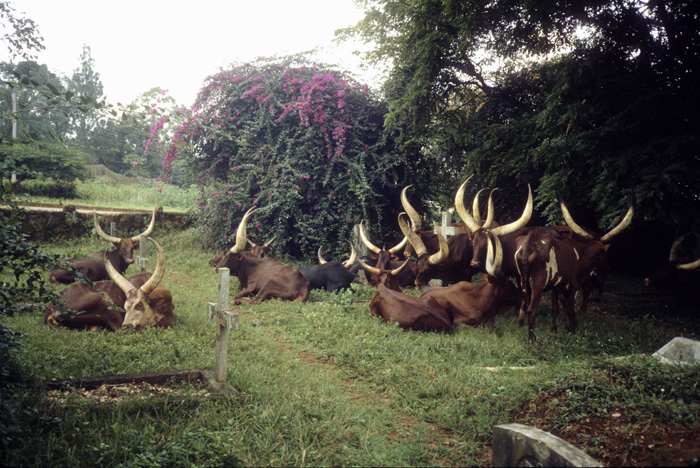
Zebu cattle, Entebbe, Uganda
Kampala was our next port of call and we were rewarded here by some excellent music from several quarters, by the leading harpist in the country, Temusewo Mukasa, by the Kabaka's xylophone band, by a few brilliant items from a Budongo band of Mbira or Likembe players near Jinja, and others.
The Ganda and Soga appear to have that combination of historic appreciation of their tribes' position in the country and pride in workmanship which is the pre-requisite to any established culture. Yet one finds strange anachronisms in the construction of their many and varied musical instruments. The xylophone in this area for example is far behind those of many tribes both in finish and workmanship. They lay the rough wooden slats onto two freshly cut stalks of banana and peg them apart with small twigs pierced into the soft pulp of the stalk. The notes are struck at their extremities and as a consequence are quickly dislodged from their positions. The twigs keep the notes apart but do not prevent their falling off when struck. No one, it seems, has thought of the simple device of drilling a hole at each node of the slat through which to insert the twigs and effectively prevent their touching each other or tailing off.
The Ssaza Chief Kago, whom we will surely remember as one of the best informed Ganda men in local musical matters, played us his own compositions on the xylophone with the assistance of his nephew who sat opposite him. He required a servant to attend him while playing for the express purpose of stretching his arm underneath the slats of the xylophone in order to return them to their correct positions as quickly as each was knocked out of place by the percussion of the rippling music. Others, less fortunately placed, kick their notes back into place as part of the normal hazards of xylophone music, developing a technique similar to that of organ players whose feet fling themselves at the diapason of the pedal notes.
Anyone with a delight in the history of pre-Western Africa must have an enthralling opportunity for study in the songs of the professionals and peasant singers of the Uganda Protectorate. It would provide a valuable corrective to the opinions of certain overseas politicians whose fraternal anxieties lead them to demand legislation for Africa in keeping with the quiet back streets of industrial Europe. Their assessments of the African scene and its requirements are far removed from those expressed daily by the gay reciters of African legends who vividly provide an insight into both the loyalties and realities of the good life as seen through the quick eyes of the common people of Africa.
Of Uganda music itself, the general impression is not melodic but rather of long and forceful recitative set against a background of urgent stringed and percussive instruments, lutes, lyres and drums. Their repeated phrases provide a boiling, bubbling mass on top of which the legend is tossed from side to side. It cannot be everyone's idea of good music, but is most certainly exhilarating,
From Uganda we moved across into new country for us, the long sweeps of the northern Ruanda downs and the densely populated temperate highlands further south. Thousands of miles of contour banks from valley to hilltop score the whole landscape with horizontal lines emphasising in outline not only the periphery of the bosom of the hills but the great mass of Hutu and Tutsi, who together with the little Twa Pygmoids populate this fertile kingdom. It has been one of Africa's outstandingly successful feudal states with a long history of six or seven hundred years. The caste system of the social structure which prevailed until white men arrived to dissolve the old order, has been as clearly marked in the music of the country. The chanting of the aristocratic Tutsi whose tallness is a remarkable feature of their physique, is Ethiopian rather than African as we know it to the south, and the honourable yet subservient part played by the lesser Hutu and Twa is as distinct and different from that of their overlords as, for example, religious is from secular music in our own communities.
It was not easy to make contact with musicians of merit as we had only a limited time at our disposal. Dr. and Mrs. Alan Merriam had been able to cover the same territory in 1951 with much more success and detail than we were able to do, and their interesting report on their findings was published in the last edition of this Newsletter.
We were, at least, lucky enough to see two sets of Ntore dancers in action, the one a performance by medium sized Hutu to the music of the diminutive Twa, and the other the genuine Imihamiridzo by tall Tutsi to the horns and drums of Hutu musicians, one at the north and the other at the south end of Lake Kivu. No other African dance in our experience is so aesthetically satisfactory as this. The music, surprisingly enough, is relatively dull from a melodic point of view, providing a blare of horns and tattoo of drums as a rhythmic background to exquisite dance routines, routines which were surely invented to be danced by young men of not less than six foot six in height. The contrast between the performances of stocky Hutu boys who gambol and jump their way through the steps of the traditional dance and the exquisite leaping, striding and posturing in the 'Crested Crane' movement of the genuine Imihamiridzo of experts with their bird-like features and elegant limbs, has to be seen to be appreciated.
One was immediately led to the vain speculation of a possible marriage of the two most complex tribal dances of all southern Africa, these Tutsi on the one hand with their full three dimensional use of the whole dance floor and the xylophone music of the Chopi orchestras on the other which would complete the whole drama of Imihamiridzo with concords befitting the elegance of their actions and the proud sweep of their golden coloured fibre headdresses.
We now entered Congo proper through mountainous volcanic scenery as beautiful as any on the continent, we were assured. For ourselves we could not comment in these superlatives as the grass fires driving out the tsetse flies from the grazing grounds of Uganda and Tanganyika a hundred miles away to the east enshrouded the whole country with a pall of smoke haze, We seemed to move under a luminous canopy, a sort of celestial tent whose extreme limits never extended more than two to three miles in any direction. From time to time great cliffs would emerge out of the opaque walls like an unexpected figure entering the tent door from the enveloping mist. The blue and pink glories of Lake Kivu under towering white cumulus clouds which are such a feature of Belgian tourist advertisements were denied us. Even the active volcano was an apparently nonexistent myth had we not seen a red glow in the night sky far higher than any normal glow should appear from more domestic causes.
From Costermansville northwards, all along the length of the Western Rift valley, we progressed with as few examples of music from the local tribes as glimpses of local mountains. From the musical angle, it was the most barren region we had experienced in all our travels. Hardly a single tune would have made sense on a recording. The simple reiteration of a few notes in endless sequence had no beginning and no ending, just the dull murmuring of simple folk as lost in the musical medium as we seemed to be in the enveloping smoke haze.
Two features only stand out in that northward journey, the flute tunes of a Nande herdsman whose four-holed flute produced more notes per hole than any pipe is supposed to emit, and our first encounter with the genuine, pale coloured pygmies of the Ituri Forest. Once we had penetrated that fabulous world of giant trees and daily rain, the smoke changed to constant cloud hanging over the tree tops. The BaMbuti pygmies of the forest are strange dignified little creatures, with puzzled faces and skins far lighter in colour than those of the neighbouring Bantu who live on the edges of the forest and exploit them for their own ends. They played a flute dance for us and sang a few songs as simple as the first warbles of a two year old child. Three small pygmy women, full grown at four foot high, sang a song with the words "Mai o da" repeated timidly to an approximation of the first three notes of "Three Blind Mice".
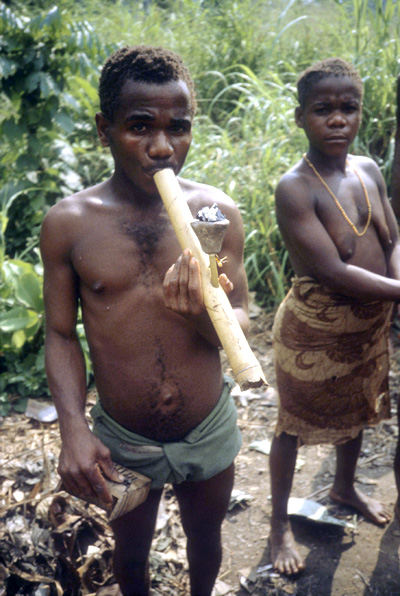
Smoking stunts your growth, Congo
On we went through the magnificent forest and across the open savannah of elephant grass through the regions of eluvial quarries where the Kilo-Moto companies wash gold out of the red stained gravel, to the very limits of the Bantu tribes in the north eastern corner of Congo. Here we found faint signs of a returning sense of music, and by the time we had skirted the north eastern corner of the Ituri Forest and travelled westwards into the regions of the Sudanic Mangbetu tribes we breathed sighs of relief that our recording apparatus was again justified.
The music of the Sudanic tribes of northern Congo is notable for the sound of their two toned 'slit drums' of all sizes with which their dances are accompanied. Carved out of great logs of wood from the forest these wooden gongs, for that is what they are, lend themselves to the craftsmen of these tribes who fashion them into fine natural shapes like great pods from the forest trees, semicircular bells, or even in the likeness of antelopes. The pygmies come out of the forest at the bidding of the local administrateur and, borrowing the musical instruments of the tribe into whose territory they have emerged, dance in a tight circle like a swarm of ants, beating drums and gongs far too large for them to manage. They yodel and shout, bang the towering sides of the pod-shaped gongs with Lilliputian fervour while their diminutive chiefs sit silently to one side in their camp chairs.
The Belgians call camp chairs by their attractive travelling name of 'Trans-Atlantiques'. The pygmies appeared out of the forests in bunches of forty or fifty at a time, the women were carrying their doll-sized babes on their backs and cooking pots on their heads, the men and boys were armed with bows and slivers of bamboo arrows while the notables each balanced a pygmy sized 'trans-atlantique' on his head. Cigarettes and salt were their reward. The salt they eat in mouthfuls from their open palms, but the cigarettes they insist upon smoking through what must surely be the longest, largest cigarette holder in the world. A palm frond is cut almost as tall as themselves. It is stripped of its leaves and the lighted cigarette is inserted at the tip. A natural hollow tube which runs through the centre of these fronds conveys the smoke, cool and delicious, to the diminutive smoker at the lower end, whose whole body expands and contracts like little blacksmith's bellows in great gasps, enveloping the happy little man in clouds of smoke as if he himself were on fire.
The dark-skinned Mangbetu exercised a fascination of mystical strength upon us not evoked to the same degree by any Bantu tribe we had met. It was perhaps from their unsmiling, unemotional features as they stood with arms akimbo watching the setting up of our recording apparatus; it may have been from their comparatively recent history of having been among the most rapacious cannibals of the continent; or perhaps from their advanced aesthetic sense which showed not only in their dress and feathered finery, but in every item of their making, their woven palm leaf caps, their smithwork, their dyed bark-cloth breeches, their women's patterned coiffures, their magnificent murals in symbolic or meaningless patterns, their remote dignity of bearing or just a combination of all these qualities reacting upon an appreciative stranger. Whatever it was, the total effect emitted the essence of a strongly developed primitive culture, with sensitivities far beyond those displayed by the average Bantu, a culture in which all their actions, their domestic architecture and equipment, their music, dancing and costume were all a part of the same spiritual entity—the essential being and spirit of the tropical African forests.
In this setting the hand of the west seemed as deadening as it was enlightening, as levelling as it was unimaginative. Ragged European clothing and aluminium Catholic medallions alike, slung like sacking from their indigo tinted bodies or looped on greasy string around their necks, seemed an intrusion as false and meaningless as the great leveller himself. What possible compromise between Mangbetu and Europe could there be which would do justice to either.
The music was both simple and complex at the same time. Simple in massed effect but composed of complex elements. The crossed rhythms of the 'slit drums' were a liberal education in themselves in the means by which dramatic effect can be achieved by a handful of folk musicians, provided each sticks rigorously to his own simple part adding it to the cauldron of boiling sound.
The very simplicity of the dance steps heightened the cumulative effect as you felt compelled to relinquish your status of foreign observer and participate in the slowly moving absorbed mass of dancers gyrating in a wide circle around the many noted voices of the battery of drums, double bells and rattles which held everyone enchanted, contented and participating in the mystery and delight of the dance. To stand outside and watch most Bantu dances is understandable. One could not perform the acrobatic and syncopated actions which most of them require without much loosening of one's conditioned reflexes. But to witness these Mangbetu or Zande dances of the northern Congo and not wish to join in the circle of dancers would be to admit dull insensitivity or phlegmatic inertia to an unusual degree.
We enjoyed them.
It was interesting to note how much the yodelling of the pygmies appeared to have influenced the music makers of the tribes immediately outside the forest limits. There was hardly a song or dance tune which did not open with a 'ooo-aa' yodel. Here the BaMbuti pygmies were called, affectionately, by the pint sized name of BaTiki-tiki.
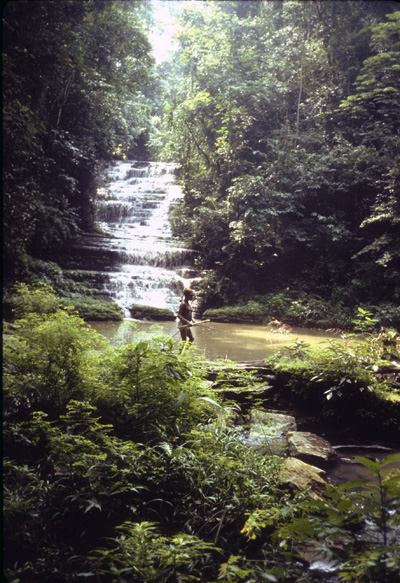
BaMbuti hunter at Staircase of Venus waterfall, Ituri forest, Congo
Here at last we were back in the land of music makers, with metal noted Likembe, with harps, flutes and xylophones. Nature is very kind to the peoples of this region, supplying them with fine raw products of the swamps and forests with which to make musical instruments which are both effectively functional and aesthetically beautiful. A handful of seed pods from some forest tree makes the perfect knee rattle; rich iron ore nearby lends itself to the hammering of blacksmiths and the fashioning of weapons of fantastic shapes and keenness; the scarlet tail feathers of Congo parrots illuminate the gala dress of thousands of dancers as they catch a spark of sunlight, the perfect colour to offset the blue tinged gloss of their bare torsoes. One must revise one's spectrum of values in the light of all this vital movement, pattern and sound if one is to understand the mind of the once cannibal Mangbetu, as much as one must harness one's emotions in the objective contemplation of a matador's veronica or the preying of a mantis.
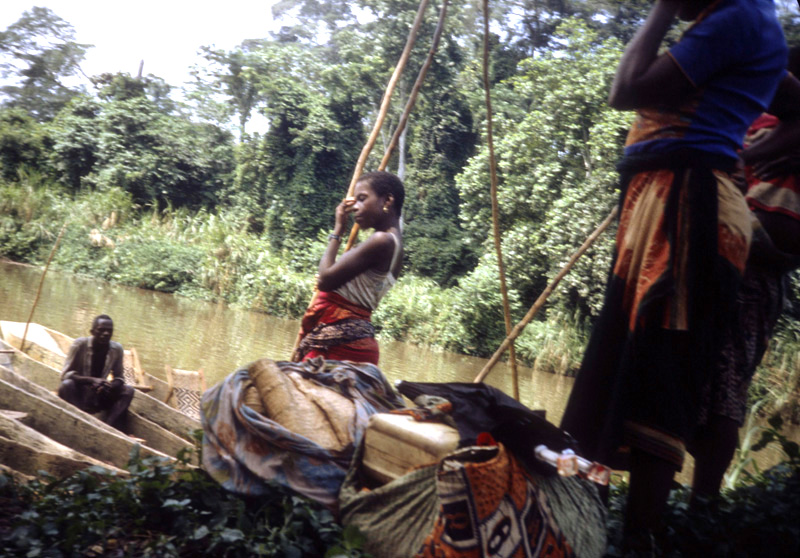
Ituri river
The journey to the River, with our backs to the forest, was in its way an anti-climax.
The prosperous river tribes had an aural interest of quite a different nature. The Congo has long been the one and, often, only line of communication with the coast. The moment one arrives at Stanleyville one is assailed with evidence of its preoccupation with trade and with the linking of communications with the districts beyond. It was here that the trading canoes of the middle Congo plied up and down the river spreading Ngala as the economic language of the river before the days of Stanley. Now, river steamers of the Mississippi silhouette push their way upstream to the Stanley Falls and glide off downstream to Leopoldville a thousand miles away. Here, in this region, the Lokele tribe made good use of their 'talking drums' speaking intelligible sentences to each other across the river or to adjacent villages on the same river bank long before Morse was born. Today the 'a b c' and the bicycle, between them, have reduced the value of drum messages and it is becoming a dying skill.
The Genya fishermen whose fish traps on the falls and whose huge dug-out canoes have made them famous through the medium of the films, sing their stirring canoe songs and beg for 'tabishi' almost in the same breath. They will stop eating a hearty meal of fish and cassava if they see you pass in order to run out, scratch their well filled bellies as they bend low and whine "Jara" (hunger) with open hand, waiting for tips. We fixed that one by returning their greeting with a happy scratch, outstretched palm and a bright "Jara" as if it were a 'Top of the morning to you'. They laughed. They had not thought of that response.
It was here that we found the eastern limits of the guitar music which had spread up-river from Leopoldville and Angola. The Arabisé members of the community, descendants of Arab slavers who attacked Stanley here on his journeys of exploration down the river, take to the guitar as readily as the Luo of Kenya or the Luba of the Southern Congo. But Stanleyville is a river port with its back to the forest, cut off from the great centres of tribal life in northern Congo which lie out beyond, and although we had hoped to travel down river to Leopoldville we were forced to change our plans and it was here that we had to leave our recordings for 1952 and return home. It had been more than just a new experience. It had been another confirmation of the fact that wherever you travel on this continent unless you have ears to hear as well as eyes to see, you must inevitably miss one of the greater fascinations of Africa.
April 26th, 1953.
Hugh Tracey's historic recordings are available from Sharp Wood Productions

















